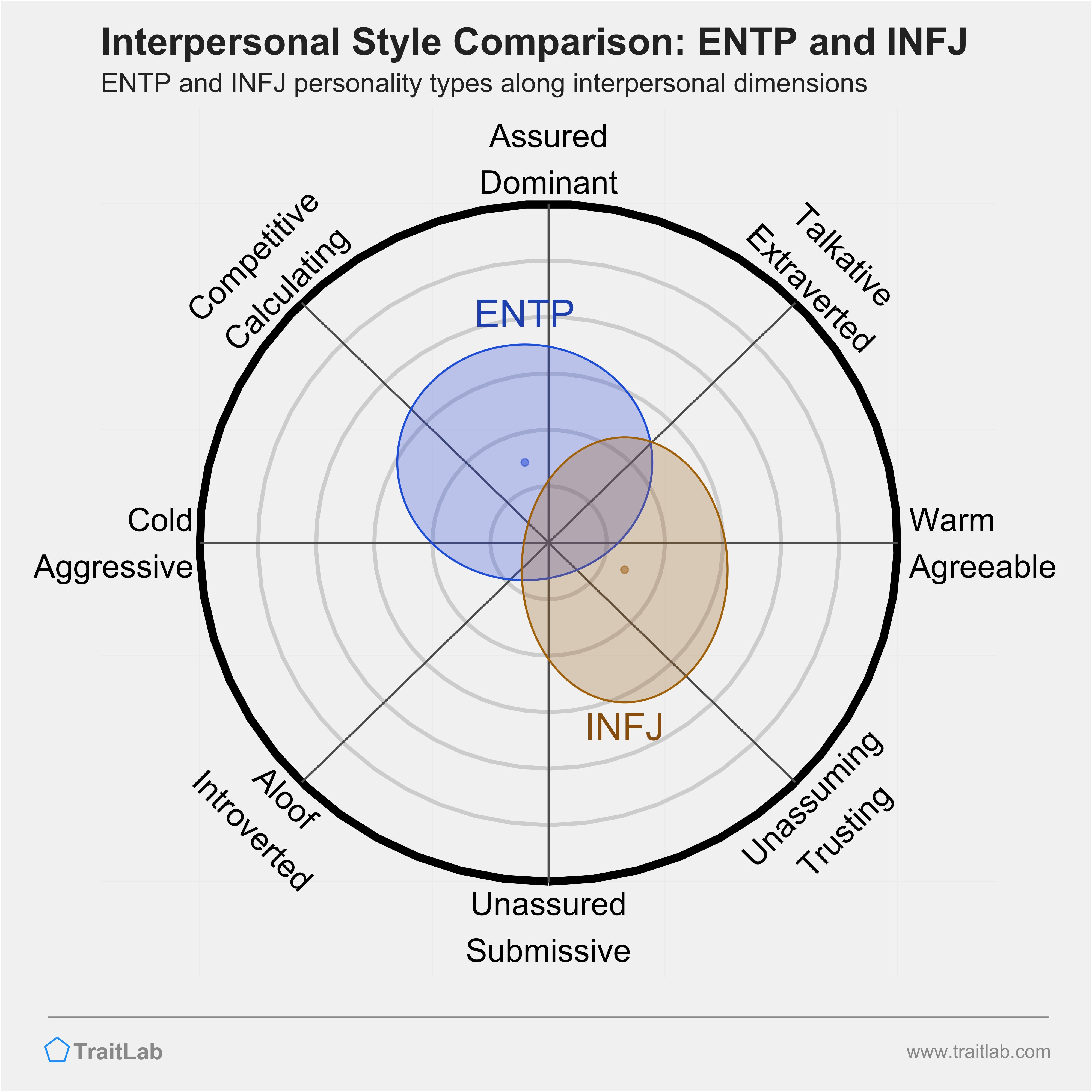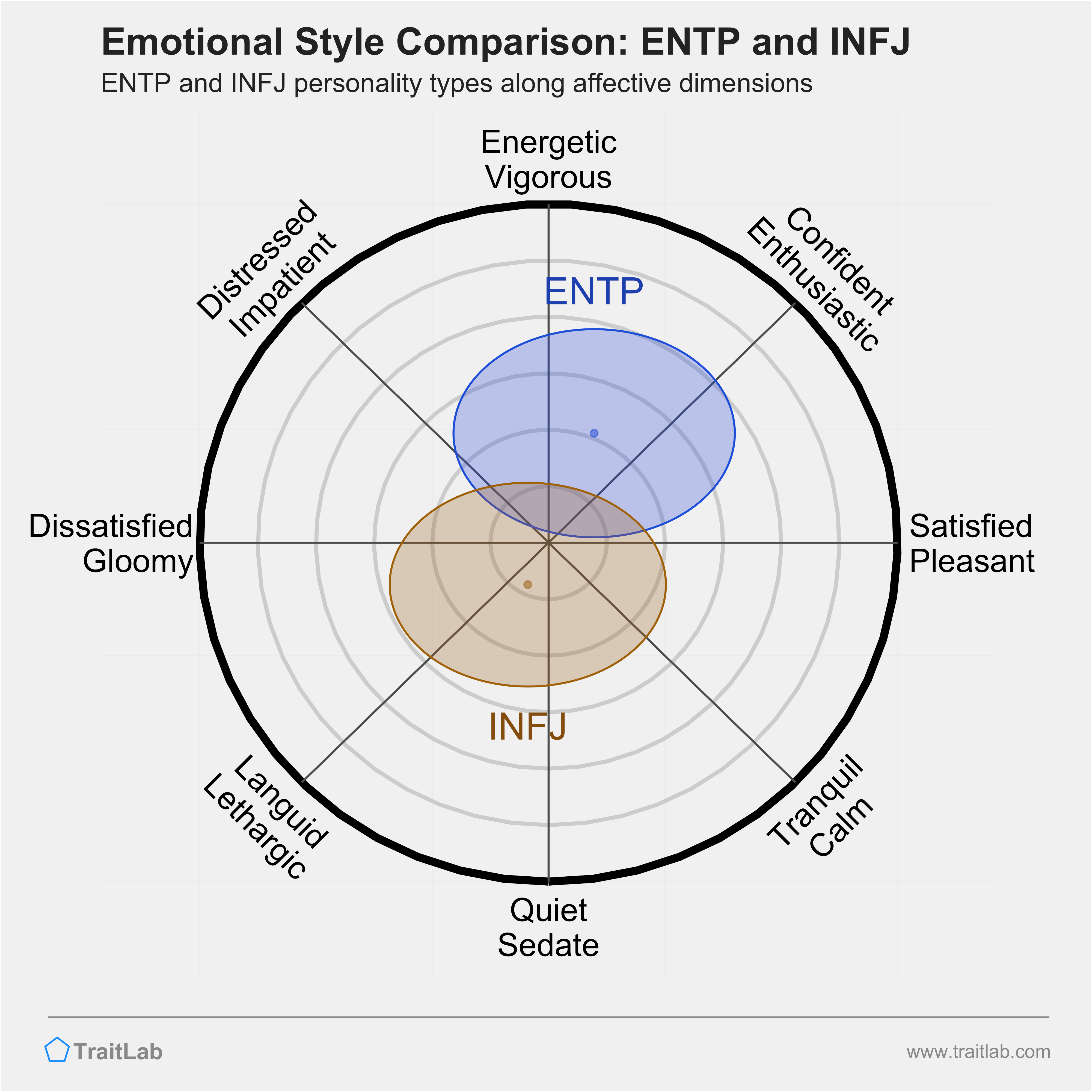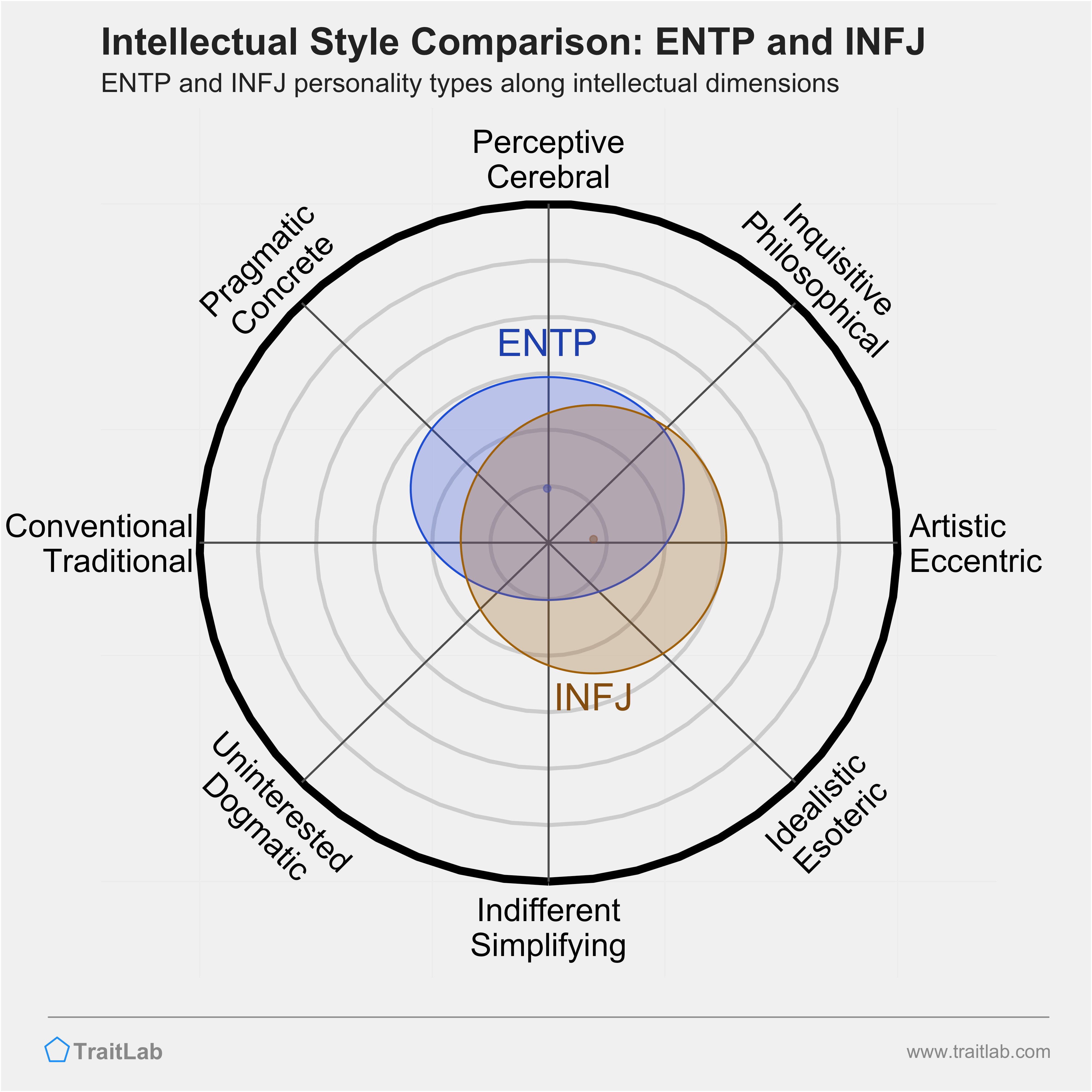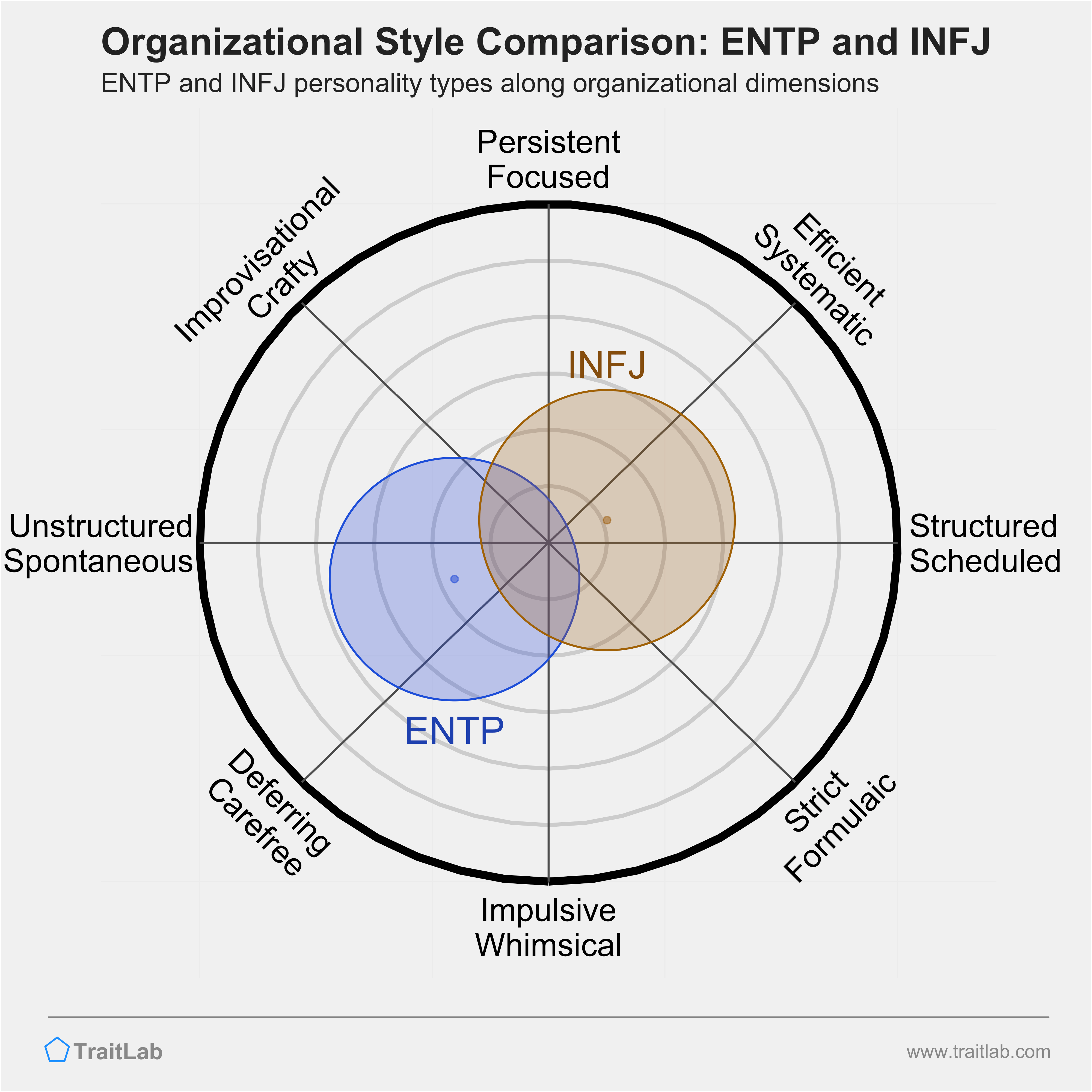How compatible are ENTP and INFJ patterns of communicating, thinking, and working?
Reading time: 5 minutes

Gregory Park, Ph.D.
Author
In this article, you’ll find a comparison of ENTPs and INFJs across five important personality domains: Interpersonal/Communication Style, Emotional Style, Intellectual Style, and Organizational Style.
One important note: the following comparisons cannot be made simply by comparing the cognitive functions (letters) of each personality type.
For this analysis, TraitLab gathered data about personality traits from thousands of participants who identified themselves as a particular type in the 16 Personality or Myers-Briggs framework.
The comparisons here show the average similarities and differences between ENTPs and INFJs. However, remember that all personality types are oversimplifications. For an assessment of your unique position in these areas, you’ll need a personalized assessment that doesn’t rely on personality types.
Jump to any section with the links below.

Do you know your personality type?
Learn about your type and so much more with TraitLab's comprehensive personality assessment.
Your particular style of communicating and interacting with others can be described fairly well by two dimensions: assertiveness and warmth.
Assertiveness describes your tendency to assert yourself, lead, and influence others in social situations, while warmth describes your tendencies to empathize and put others’ needs ahead of your own.
People with the same personality type often share some similarities in assertiveness and warmth. In the graph below, you can see where most ENTPs and most INFJs fall along both of these dimensions.
First, take a look at where people in each type, on average, fall in this interpersonal space.

ENTPs often manage, direct, and try to lead others. At their best, they provide guidance and leadership, and naturally command respect. ENTPs may be domineering, forceful, or overly direct. At their worst, they can be overbearing and micromanaging.
INFJs often agree, trust, and cooperate with others. At their best, they are friendly, affectionate, and bring out the warmth and sympathy in others. INFJs may be too agreeable and quick to compromise. At their worst, they may seek approval and agreement too much, and be dependent on the approval of other people.
As an ENTP, one notable difference between you and most INFJs is in your interpersonal warmth. You are likely on the colder, more combative side of the spectrum. Compared to you and other ENTPs, INFJs’ can sometimes feel overly focused on feelings and intentions, rather than the facts of the matter at hand.
Another important difference between you and most INFJs is in your relative assertiveness and dominance in social situations. Like many ENTPs, you tend to be on the more assertive side and feel comfortable taking charge and making decisions. Often, this pairs well with INFJs more reserved and passive style, but you’ll want to be careful about being overly domineering, forceful, or direct. Unlike you, INFJs may need additional time and space to share their thoughts and ideas.
Another characteristic of your personality is your emotional style — your tendencies towards different kinds of moods. There are two dimensions that influence emotional style: arousal and valence.
Arousal describes your relative energy level across different situations. Those with high baseline levels of arousal tend to be generally more alert, active, and engaged, while those with a lower baseline are more reserved, subdued, and inhibited.
Valence describes whether these moods tend to be positive (pleasant) or negative (unpleasant). People with a more positively valenced style are more likely to experience emotions like joy, enthusiasm, satisfaction, and serenity. People with a more negatively valenced style are more likely to experience sadness, frustration, dissatisfaction, and anxiety.
The graph below shows where each type, on average, usually sits in this emotional space.

ENTPs tend to be energetic and enthusiastic across most situations. They take on new challenges with excitement, confidence, and a sense of adventure. ENTPs are usually more optimistic than most people, and they generally feel like they can handle what life throws at them.
INFJs have a tendency to be quiet and inhibited. Compared to most people, they can easily drift into gloom and melancholy. They see the glass as half-empty and have a more skeptical outlook and a hesitant approach to life. For better or worse, INFJs tend to notice the negatives in most situations. In stressful times, they are more likely to withdraw quietly and retreat inward, rather than share their frustration with others.
As with most ENTPs, you tend to have a higher baseline energy level than most INFJs. Between the two of you, you are more likely to seek out engaging activities — perhaps social events, outdoor adventures, or a new class, depending on your interests. However, you may find that most INFJs do not share your enthusiasm and excitement. In general, you likely crave stimulation more than your INFJ counterparts, and balancing your different appetites for excitement can be an ongoing challenge.
Another difference between ENTPs and INFJ is in their typical emotional valence, which describes tendencies towards positive or negative emotions. You and most ENTPs tend to fall on the more positive side. Compared to most INFJs, you and most ENTPs experience positive emotions such as joy, satisfaction, and happiness more often than most INFJs. INFJs have the opposite pattern, and they tend to gravitate towards more negative emotions.
These subtle emotional differences often surface in your reactions to new information. The same news that sparks enthusiasm in you and most ENTPs can induce worry in INFJs. Compared to ENTPs, most INFJs may need additional time and space to recover from stress.
Your intellectual style describes how you receive, process, and pursue different kinds of information. Differences in intellectual style are captured well by two dimensions: ideas and aesthetics.
Ideas describes your appetite for new information and your interest in complex, challenging material. People high on the ideas dimension have an appreciation for complexity and technical details. People lower on ideas are less interested in learning for learning’s sake, and they prefer to simplify complex topics down to the essential details.
Aesthetics captures your relative interest and sensitivity to aesthetic information and its emotional impact. People higher on the aesthetics dimension usually have strong artistic interests and a deep appreciation for beauty in many forms. Those lower on aesthetics tend to value practical application over artistic merit and usually adhere to more conventional standards of beauty.
In the graph below, you’ll see where ENTPs and INFJs, on average, fall in this intellectual space.

ENTPs are usually highly effective, efficient thinkers, capable of processing large amounts of complex information and distilling it down to its most useful elements. They are pragmatic and grounded and prefer to apply their knowledge to conventional, practical pursuits.
INFJs tend to be deep thinkers — bright, curious, and philosophical. They are highly receptive to new ideas and drawn to complex, abstract concepts. INFJs enjoy taking in large amounts of information and typically have one or more creative outlets.
As an ENTP, you and many INFJs share a love of learning new, challenging ideas. You both appreciate complexity and nuance, and the two of you can spend hours discussing and debating a wide range of topics. When you are together, you often elevate the conversation to a more theoretical, philosophical level.
Another difference between ENTPs and INFJs is their relative interest in aesthetic, artistic, and emotional experiences. As a ENTP, you tend to be more practical and focused on tangible results, while your INFJ counterpart is more likely to be drawn into the emotional and artistic aspects of an experience. In addition, ENTPs and INFJs often differ in their receptivity to unconventional and eccentric ways of thinking. Like many ENTPs, you often lean towards well-worn, conventional approaches and view new alternatives with healthy skepticism. In contrast, INFJs are quicker to do away with convention and embrace a new approach.
Your organizational style describes your habits around organization and planning. Your organizational style influences how you structure your time and physical space. Differences in organizational style fall along two dimensions: industriousness and orderliness.
Industriousness describes your persistence, need for achievement, and intensity of focus. People higher on industriousness usually organize their behavior around a few important long-term goals. People lower on industriousness are usually more focused on the present and will more easily change their focus when new opportunities appear.
Orderliness describes your need for regularity, order, and structure in your environment. People higher on orderliness prefer tidy, organized physical spaces, detailed schedules, and reliable routines. People lower on orderliness can tolerate more disorganization and prefer a more spontaneous, unstructured approach.
The graph below shows the average position of ENTPs and INFJs along these dimensions of organizational style.

ENTPs thrive in unstructured environments with fewer constraints and more room for improvisation and serendipity. They generally focus on enjoying the present rather than preparing for the future. ENTPs highly value spontaneity and the flexibility to change their mind, and they resist setting hard deadlines or rigid expectations.
INFJs are usually systematic and highly organized. They like setting big, long-term goals and then creating detailed plans to accomplish them. INFJs are generally good at ignoring distractions and making steady progress through consistent routines and habits.
Like many ENTPs, you and most INFJ often differ in your need to achieve explicit goals and use your time productively. While you embrace the here and now, your INFJ counterpart is often thinking about and planning for the future. When you are keeping your eyes out for new, interesting opportunities, INFJs are usually working away with their heads down. This difference between your present-oriented mindset and their future-oriented one can create occasional tension. However, this difference also helps you balance the other out at times. Your INFJ counterpart often needs you to break them out of their need for productivity and efficiency while they can provide you with additional focus and motivation.
A second difference between ENTPs and INFJs is in their relative need for routine, structure, and order. You and most ENTPs are more comfortable with an unplanned, spontaneous approach to life, while your INFJ counterpart often wants plans, schedules, and well-defined procedures. INFJs thrive on routine and predictability, whereas ENTPs find the same level of organization to be overbearing and constraining. These differences in tidiness, punctuality, and comfortability with deviating from social expectations can be a consistent source of conflict between the two of you.
Most people have complex personalities and don’t fall into a single personality type.
With TraitLab’s comprehensive analyses of your traits, strengths, and interests, you can see how your personality compares to all 16 types. Start building your personality profile by creating a free account today.
For comparisons between ENTPs and other types from the 16 Personality typology, visit any of the type pairings below:
For comparisons between ENTPs and other Enneagram types, visit any of the type pairings below: